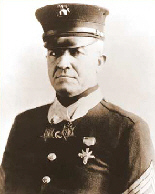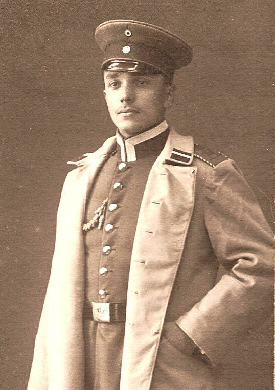
TRENCH REPORT: It's almost "All Quiet On the Western Front," but I notice some trends I'd like to pass on to you. More and more people are researching their families and sending inquiries on checking on their World War I family members. We have an FAQ to help such folks that is oriented to American veterans. (link). We are also able to provide starter tips and referals to resources for some other nationalities. Another trend we are tracking is the passing of the old veterans, which is raising consciousness of the war, its scale, importance, and the sacrifice of those who served. Updates on these movements to follow. MH
This Month's Internet Feature
Women at War
Mobilizing Women-Power in the World War
Women at War [Multiple Articles]
30,000 Were There [Women in US Military]
Ten Books About Women in the Great War
Marraines de Guerre:
Godmothers for the Poilus
History of a Hello Girl
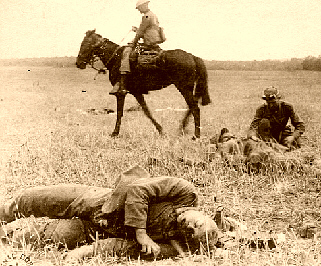
Collecting the Dead, Unidentified U.S. Battlefield
New at Our Own & Our Friends' Great War Websites
Click on Title or Icon to Access
|
At Dave Homsher's OVER THERE
At Mitch Yockelson's BORROWED SOLDIERS
At Great War Society Sites
At the WFA-USA
|
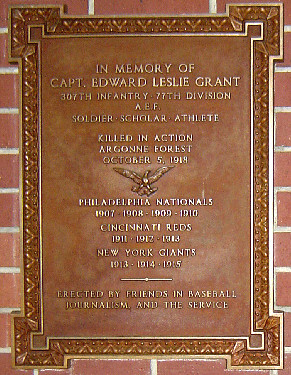
Capt. Eddie Grant Plaque
Giant's Ball Park, San Francisco
Replaces the Missing NYC Polo Grounds Original

One of the most famous quotes of the Great War came from a tough U.S. Marine Gunnery Sergeant, who was also a prewar double Medal of Honor recipient, named Dan Daly. During the opening attack at Belleau Wood, he called to his men: Come on, ya sons-of-bitches, you want to live forever?
But what ever happened to Sgt. Daly after his immortal moment? He was wounded subsequently at Belleau Wood, taking a machine gun bullet to his hip. Recovering in time for the assault on Blanc Mont Ridge in the Champagne in October, he was wounded twice in that action. He left the Marines in 1920, moved in with his sister on Long Island and never married. A baseball fan, Daly took a job as a night security guard at Brown Brothers, Harriman & Company in New York City, so he could attend ballgames during the day. In the bleachers at New York's Polo Grounds he would have sat just behind the original version of Capt. Eddie Grant's plaque [see above], which was mounted in centerfield. He avoided publicity and never played on his notoriety. One of America's greatest warriors ever, Dan Daly died of a heart attack in April 1937 and rests today at Cypress Hills Cemetery on Long Island. Compiled by reader Bradley Omanson, primarily from George Clark's Legendary Marines of the Old Corps
|
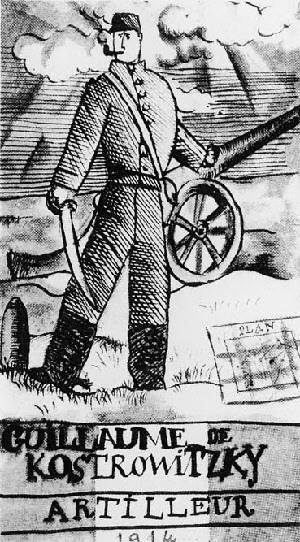
Sketch of the Poet Known as Apollinaire
Pablo Picasso, 1914
GREAT WAR 2008 EVENT CALENDAR
|
|
|
WFA-Pacific Coast Branch General Mtg &Seminar
Canadian Scottish Armory, Victoria, BC
March 7-9, 2008 (information)
|
WFA-USA National Seminar
Carlisle Barracks, PA
America's Great War -
America's Great Warriors
September 12-14 2008 (information)
|
Western Front Association
U.S. Branch Chapter Meetings
Check for Your Region
Regularly Updated (details)
|
Great War Society Monthly Chapter Meetings
Berkeley, San Francisco and Palo Alto, CA
Regularly Updated (details)
|
Send additions/corrections:
Email Response
|

Memorable Event
|
German Army Resumes the Offensive in the East,
Leading to the Treaty of Brest-Litovsk
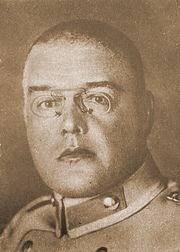
German General
Max von Hoffmann
February 18, 1918
Click on Image for Documents Including Treaty
|
|
The Great War: Midwife to Modern Memory? a dialogue between scholars Jay Winter and Robert Wohl takes place on Saturday, February 9, 2008, at 10:00 a.m., at the Central Library, 14 W. 10th Street, Kansas City, Mo. The program is the fourth public dialogue in "The Legacy of the Great War: 90 Years On" series. Admission to this event is free, but reservations are recommended. Call 816.701.3407.
Last month, our film reviewer Andrew Melomet presented a review of the new film, My Boy Jack, the story of Rudyard Kipling's son John, who perished in the Great War. Trip-Wire readers, authors Tonie and Valmai Holt reminded me that they were the original authors of the book of the same title. Their work, however, also addresses the questions surrounding the announced location of John Kipling's body in 1992. Learn more about their research and order the book here if you would like to learn more (link).

It is claimed that the Battle of the Somme destroyed the old German Army by killing off its best officers and men. It killed off far more of our best and of the French best. . .Had it not been for the inexplicable stupidity of the Germans in provoking a quarrel with America and bringing that mighty people into the war against them just as they had succeeded in eliminating another powerful foe-Russia-the Somme would not have saved us from the inextricable stalemate. David Lloyd George, Memoirs
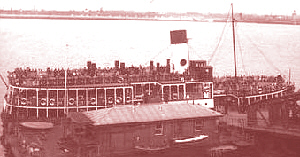
Daffodil, Mersey River Ferry
Called to service for the Zeebrugge Raid of April 1918 to carry an assault team. Addditionally, played the critical role of tugboat in maneuvering the main assault vessel, HMS Vindictive, to tie up at Zeebrugge Mole. Given the honorific title Royal Daffodil when it returned to passenger service.
|
|
Command Post MF2, Verdun Battlefield
|
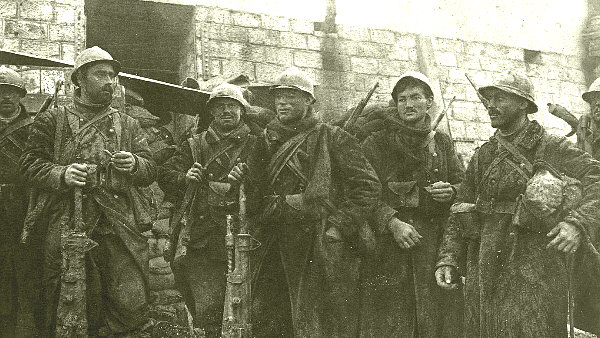 |
October 1916
Moroccan Colonial Infantry Who Recaptured Fort Douaumont In Front of MF2
From Tony Langley |
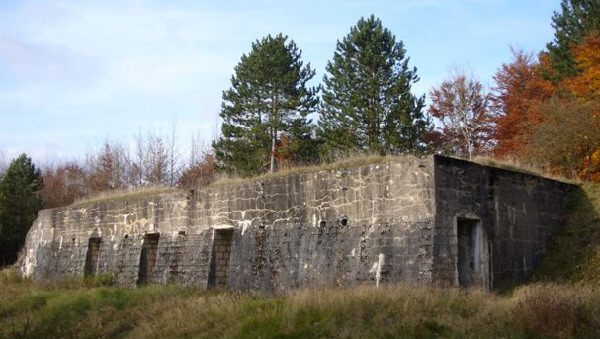 |
Sitting Quietly Today, MF2 Near Fort Douaumont
By Christina Holstein |
|
|
|
Page Two
|
|
|
|
World War I veteran Louis de Cazenave died January 20th at age 110, leaving just one known French survivor of the 1914-1918 conflict. De Cazenave, who took part in the Battle of the Somme, died in his home in Brioude in central France, said his son, also named Louis de Cazenave.
"He died at his house, in his sleep, without suffering," the son said. The last known French veteran of World War I is Lazare Ponticelli, also 110.
The last surviving German army veteran of World War I is reported to have died in Hanover, aged 107. No official confirmation was available nor is it ever likely to be. Germany keeps no official records on its veterans from the two world wars.
Dr. Erich Kästner, who was born on March 10, 1900, died on January 1, 2008, according to an announcement posted by his family in the Hannoversche Allgemeine (newspaper). According to the Wikipedia on-line encyclopedia, Kästner was the German Army's last known veteran of the war. He joined up in July 1918, four months before the end of the war, and served on the Western Front.
|

|
One of Verdun's Destroyed Villages
By Christina Holstein
|
The Battle of Verdun wiped nine villages off the map so completely that the French
government ordered that none should be rebuilt. Their sites have been largely overtaken by
forest and apart from hunters, animals and the occasional visitor, most of them are silent and
forgotten. However, the destroyed villages have been allowed to retain a legal identity. Each
one has a mayor, a chapel in which mass is celebrated once a year and a village cemetery in
which the descendants of those who lived in the village before 1914 may be buried today.
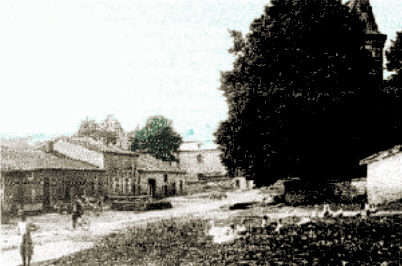
Above: Bezonvaux's Grande Rue Before the War
(Village Church Steeple Visible Behind the Large Tree)
Right: Bezonvaux's Village Church, Mid-Battle,
Before Being Leveled
(Courtesy of Tom Gudmestad)
|
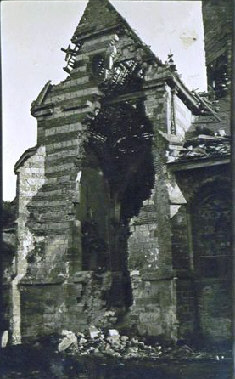 |
Although no archeological investigation has ever been carried out in any of these sites, one of
them has recently been cleared of undergrowth so that the outlines of the old houses can be
seen. This is Bezonvaux, a little place on the eastern edge of the Verdun battlefield. It must
have been a tranquil place before 1914, sheltered from the westerly winds by the Meuse
Heights and linked to the outside world by a light railway that brought news from faraway
places. Military service also brought new ideas to the young men of the village, some of whom
served in distant Tonkin. What must their sisters have thought about their adventures?
Here is a series of recent photos of Bezonvaux, which gives an idea of the site as it is today:
 |
A. Shelling Along the Old Village Street |
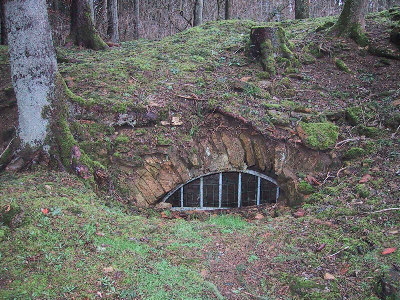 |
B. Cellar Window of the Priest's House |
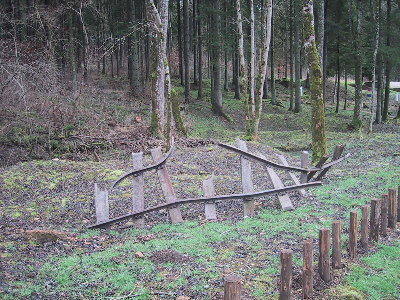 |
C. Damaged Light Railway Line |
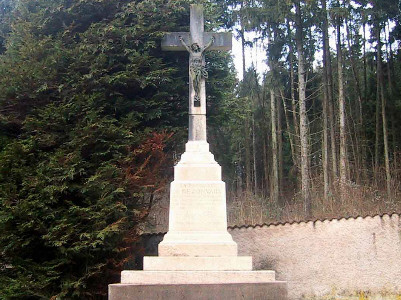 |
D. Memorial by the Modern Chapel |
|


Local Visitors and Aussies at Ghiza Encampment, 1915
Click Here to Visit War in a Different Light
|
| Eyewitness: D'Annunzio's Flight To Vienna, August 9, 1918
|

D'Annunzio and His Pilot Capt. Palli Before the Mission
Gabriele D'Annunzio, poet, propagandist and already a war hero, took command of Italy's First Air Torpedo Squadron in March 1918 and subsequently set up the San Marco Squadron that bombed Pola. He decided to wage psychological war on the Austrian public with a spectacular aviation feat. On his third attempt, D'Annunzio succeeded in leading a squadron of eight aircraft to Vienna and dropping 400,000 propaganda pamphlets written in Italian and German. The remarkable feat involved a 621-mile trip, twice crossing the Alps at 10,000 feet. His account of the flight:
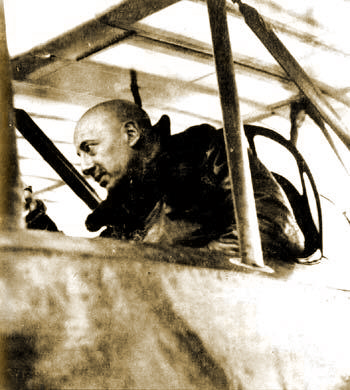
D'Annunzio Preparing For takeoff |
When we left at 6 o'clock in the morning the weather was splendid, but we soon were enveloped in a thick mist. We kept at a height varying from 8,000 to 11,000 feet. In crossing our former frontier I was deeply affected at looking down upon Cividale and the wide stretches of our country that have been held for the last nine months by the enemy.
We reached Vienna about 8 o'clock in the morning and descended to within 1,500 feet. The people in the streets were at first terrified and fled in panic until they saw that we were throwing out only manifestoes. Then crowds assembled and watched in intense curiosity. I particularly wished to approach close to the museum that contains the authentic image of St. Catherine of Alexandria, and made a detour which permitted observation of this point.
The weather became bad on our return trip, and we experienced dangerous air currents while crossing the Alps. We also were attacked by hostile artillery fire and a fleet of hydroplanes, but came through safely by noon of the same day.
The Manifesto authored by D'Annuzio himself:
People of Vienna: You are fated to know the Italians. We are flying over Vienna and could drop tons of bombs; on the the contrary, we leave a salutation and the flag with its colors of liberty.
We Italians do not make war on children, the aged, and women. We make war on your Government, which is the enemy of the liberty of nations--on your blind, wanton, cruel Government, which gives you neither peace nor bread and nurtures you on hatred and illusions.
People of Vienna: You have the reputation of being intelligent; why then, do you wear the Prussian uniform? Now you see the entire world is against you. Do you wish to continue the war? Keep on then, but it will be your suicide. What can you hope from the victory promised you by the Prussian Generals? Their decisive victory is like the bread of the Ukraine--one dies while awaiting it.
People of Vienna, think of your dear ones, awake!
Long live liberty, Italy and the Entente!
|
Source:
New York Times article
August 11, 1918
|
|

|
1918 on The Western Front
By Tony Noyes
February
Biding Time
|
To the man in the frontline trench, whether enlisted or a junior officer, there was no difference now in the absolute discomfort in which he had lived since winter began. He had made himself comfy as he could, but comfort was not easily attainable given his appalling surroundings. He endured. . .and hoped for an end to the torment--if death did not claim him first. Many men did not endure, and suicide was the only way out.
At the upper end of the social scale, planning for the campaigns of this year was well advanced by the generals and headquarter staffs. The British Army was moving some of its divisions south to extend its line, taking over some twenty miles at the request of the French Army. There were now twenty-six divisions (Second and First Armies) in the line from Ypres to just north of Arras, a distance of some fifty-six miles. Continuing south there was Third Army, some fourteen divisions covering twenty-eight miles. South of Third Army in the weakest position, under General Gough's command, was Fifth Army, twelve infantry and three cavalry divisions covering forty-two miles, bolstered by the French Sixth Army on their right. This was now the fifth year of the war, and the soldiers the British Army could not see any ending. Many of its men were very young and inexperienced, the older men were worn out, but morale was adequate.
The French Army, under the cautious Petain, was in a similar state and waiting for the Americans. There were no planned major events on the French military calendar for early 1918. A man of different temperament, Ferdinand Foch, however, was in the wings, prepared for the desperate moment that would bring him to the heights of command.
The American Army was trying hard to get "Over There" but making rather heavy weather due to lack of training, supplies and organizing senior military management acceptable to General Pershing. Only four divisions were in France at this time, and half of the 2,000,000 Americans to serve in Europe would not arrive until after June 30, 1918.
|
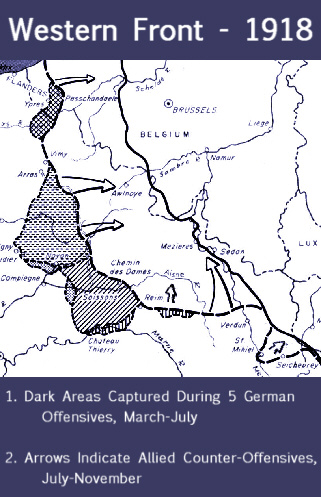
Ominously, however, the German Army was organizing to increase its size on the Western Front with the addition of eighty divisions moved from Russia following the uneasy peace with that country. These men would allow Hindenburg and Ludendorff to take the offensive in early 1918. They hoped to deal decisive, final blows to finish the war in Germany's favour before the Americans arrived.
|
|
If you are travelling to Europe and would like to visit these fields of memory for a detailed tour, please contact experienced guides Tony Noyes or Christina Holstein at Verdun Tours
|
|
|
Subscribe to Our New On-Line Magazine
|

|
|
|
Page Three
|
 |
R.I.P. George MacDonald Fraser,
Editor of The Flashman Papers
By Trip-Wire Editor Mike Hanlon
|
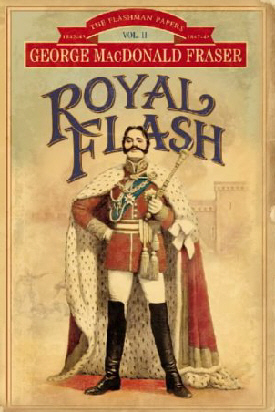
Second Packet of the Flashman Papers |
I'm sad to announce that I have lost a literary hero. George MacDonald Fraser --hereafter GMF--(1925-2008), soldier, author and screenwriter, who acquired the lost papers of that most admirable Victorian, Brigadier General Harry Paget Flashman, V.C. (1822-1915) in 1965 and released twelve annotated packets of them over the next four decades, died on the 2nd of January. Quickly recognizing after his discovery that the author of the documents had actually made an earlier literary appearance, GMF scrupulously wove the two narrative sources together. In the roman à clef Tom Brown's School Days, Flashman (or Flashie as he is known to friends and admirers) is portrayed as the terror of the title character's life--a drunken, cowardly bully, who eventually finds himself expelled from Rugby for his misdeeds. In his own writings, discovered over a century later by GMF, we learn, however, that Flashman subsequently redeemed himself from disgrace, building a career of distinction during which he met nearly every notable figure and participated in every major historical event of the 19th century. Yet surprisingly, Flashman with his own pen presents himself as even more malingering, white-livered and rapacious than he was described in Schooldays and--to the reader's horror--seems to relish adding gratuitous examples of a certain lack of gallantry and restraint when it comes to the ladies fair. Lots of examples. (Actually, lots and lots of examples)
Clearly, he had seen a manuscript of the novel in which he was libeled--obviously the product of a resentful "fag" like Tom Brown, who had received a well-deserved back of Harry's hand for some infraction--and decided for some odd reason to build a secret resume atop that unpleasant depiction. Possibly in some way his own writings were intended to further Flashie's recurring work as an espionage agent. Count me as a skeptic, though, about this scurrilous side to Flashman. How, I've often wondered, could such a weak-charactered individual manage not only to survive such military disasters as the Retreat from Kabul in the First Afghan War, the Charge of the Light Brigade, the Sepoy Mutiny, and Custer's Last Stand but also to receive the highest honors for his conduct and courage after each episode? Certainly any of the distinguished persons Flashman came across in his adventures--people like Wellington, Disraeli, Franz Josef, Abraham Lincoln and Queen Victoria and her vast network of relatives spread across the royal houses of Europe--would have crushed him underfoot had he revealed such egregious personality traits while performing his multifarious duties as a soldier, diplomat, lottery official, protector of distressed females, missionary, or Chairman of the British Opium Company.
The best way to honor GMF is to get acquainted with Harry Flashman. Start out reading the first two packets GMF prepared for public dissemination. In Flashman, we meet young Flashie engaging the unctious Tom Brown and sanctimonious Matthew Arnold at Rugby, watch sadly while his tenderhearted father administers some "tough love" to his unjustly persecuted son, and later journey with the new Lieutenant Flashie and an ill-fated British Army to picturesque and craggy Afghanistan. Then in Royal Flash we observe a more mature Harry crossing swords with a deliciously vicious up-and-coming Prussian official named Otto von Bismarck and falling under the spell of the seductive monster Lola Montez. After this introduction, you will probably be hooked and can than select another of the Flashman packets. For World War I students, however, a peripheral GMF source is essential reading. In his novel, Mr. American, which is set in prewar England, he borrows a factual episode from the papers for literary color. The protagonist of that novel finds himself invited to Buckingham Palace on the very August 1914 night war is about to be declared. The Royal Family, being tied up with other matters, shunts their guest to an old, but reliable, family friend for brandy and conversation, none other than that great man, General Harry Flashman, V.C. Flashie's comments on what is about to unfold are priceless.
Thank you, George Macdonald Fraser, for bringing Flashman to us. Your other novels and scripts are pretty good, too, but Flashie is The Man. (Read the GMF Tribute by Military Historian Max Hastings)
|
World War I Headlines
in the
21st Century
|
|
 |
The Odyssey of the
Log of the U-35
By Andrew Melomet
|
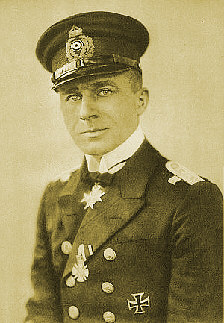
Lothar von Arnauld de la Perière |
The top-scoring U-boat ace of both world wars was Kapitan Leutnant Lothar von Arnauld de la Perière. How did an Imperial German Naval commander have a French name? I've read two different accounts as to his name's origin. The first is that he was the son of a French officer captured in the Franco-Prussian War who decided to stay in Germany. The second version I've read traces the family back to an 18th-century soldier of fortune great-grandfather who after a disagreement with the Duke of Bourbon offered his sword to Frederick the Great. The following generations would serve either in the Army or the Navy.
In 1903, when he was 17, Von Arnauld joined the German Navy. Before the war he served as torpedo officer aboard the cruiser Emden. Then he became aide-de-camp to Grand Admiral von Tirpitz and was serving on the Admiralty Staff when the war started. First, von Arnauld tried for a zeppelin command. But with no zeppelin commands available he eventually found himself taking command of U-35. From January 1916 to March 1918 he racked up a formidable record, sinking 194 ships totaling over 453,000 tons. Under his command, the U-35 fired only four torpedoes, one of which missed the target. Von Arnauld's weapon of choice was his 88mm deck gun. He was awarded the "Blue Max," the Pour le Mérite, Germany's highest award and asked for and got an autographed photograph from the Kaiser. Later the Kaiser sent him a handwritten personal letter of commendation.
The German High Command realized they had a "star performer" in the Navy, and just as they had assigned a film crew to von Richthofen's squadron, they assigned a film crew of one to be the official cameraman on the March/May 1917 patrol of the U-35 in the Mediterranean and eastern Atlantic.
After slipping past Gibraltar, the U-35 began its hunt. In an interview after the war with Lowell Thomas for Raiders of the Deep (1928), von Arnauld described how the cameraman operated: "It was on this voyage that we had a movie man along. Poor devil! His face still haunts me. Pea green it was most of the time. You see, he had never before gone to sea on a submarine, and he was a sufferer from mal de mer in its most virulent form. Usually he stuck to his camera crank as a real film hero should. Shells and bullets and oncoming torpedoes could not drive him from it. But sea sickness did. There were times when he longed for a shell to come along with his name written on it, to end it all. Then, when Neptune waved his wand and stilled the rolling deep, that cinema man was a hero once more. If we got into a rough-and-tumble gunfight with an armed ship he would take his own sweet time and would coolly refocus his magic box and switch lenses as though it were a hocus-pocus battle on location instead of grim reality." This patrol saw the U-35 sinking twenty-three ships, totaling 68,000 tons.
The film was released in Germany as Der Magische Gurtel (The Enchanted Circle). The title was a reference to a statement by Churchill. The footage shot has been used and reused in numerous documentaries on submarine warfare and the naval war of World War One.
Eventually the British captured a copy and released their own version for propaganda purposes with new English intertitles under the title "The Exploits of a German Submarine (U35) Operating in the Mediterranean". This version and the original German release are currently available on VHS (PAL and NTSC) restored by the Imperial War Museum
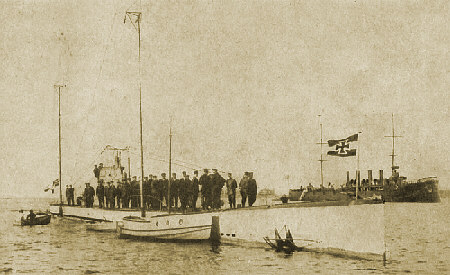
U-35 in Harbor
And, later, the Americans got hold of copies, as well. Rowland V. Lee, a former actor at the Thomas Ince studio and later a director (Son of Frankenstein, etc.) served in the front lines and fought in the Battle of St. Mihiel. He worked on the "Smiles Films," professionally-shot movies of families at home shown to the troops in Europe. Lee saw a captured print of Der Magische Gurtel at Coblenz, American Occupation Headquarters. He wanted to get hold of the film and ship it back to the States as a historical record. After the projectionist left, Lee piled up the film cans in a corner and hid them under some newspapers. When he returned later the cans were gone. J.H. Mackzum, a German-born Knights of Columbus secretary found the hidden cache and got them off to Hearst News, which featured them in the newsreel Hearst News No. 64.
The New York Times reviewed this footage on November 11, 1919, stating that "these pictures were made by officers on German submarines and were obtained from the present German Government by J.H. Mackzum, a Knights of Columbus secretary, who brought them to America." On January 5, 1920 the New York Times printed another review possibly based on the British release. "The most unusual and most powerful picture on the program is one entitled, "The Log of the U-35," which, like a similar film brought here by J.H. Mackzum, a Knights of Columbus secretary, and shown at the Rialto seven weeks ago, is said to have been made on a German submarine during the war and to have been obtained by allied representatives since the armistice. It shows cargo steamers and a picturesque schooner stopped by the submarine, wounded by its shells and bombs, and then sinking, each one slowly at first, with a different turn or roll of dumb helplessness before finally disappearing with a hurried plunge into its grave. For those to whom ships are something human, or magnificently triumphant human creations, these pictures of their assassination by forces controlled by men are overwhelmingly tragic--or, to the mood of despair, hellishly comic."
World War I Films of the Silent Era released by Image Entertainment includes a version of The Log of the U-35 that is a combination of the 1919 British version and the 1920 American versions of Der Magische Gurtel. This collection also includes the documentary Fighting the War (1916), The Secret Game (1917) directed by William C. de Mille and starring Sessue Hayakawa, Florence Vidor, Jack Holt and Charles Ogle. The Moving Picture Boys in the Great War (1975) narrated by Lowell Thomas is included as a "Bonus Documentary." I highly recommend this collection.
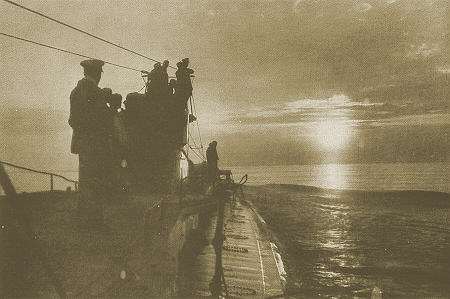
U-35 in the Mediterranean
And what happened to the U-35 and von Arnauld? The U-35 was transferred to England after the war and was docked in Blyth from 1919 to 1920 before being broken up. Von Arnauld went on to command the third cruiser named Emden from September 1928 to October 1930. He taught at the Turkish Naval Academy from 1932 to 1938. Von Arnauld served in the Kriegsmarine as a vice-admiral and held commands in occupied Europe before dying in a plane crash in France in February 1941.
Andrew Melomet, Proprietor of Andy's Nickelodeon, will answer your Great War film or video inquiry. He is also soliciting your recommendations for the WWI Filmography he is compiling for our readers. Just click HERE.
|
|
| The following are thanked for their contributions to this issue of the Trip-Wire: The many of you who sent the news about the two veterans who passed away, Rick Metz, Robert Kellner, Tony Langley, Christina Holstein, Tony Noyes, Bradley Omanson, Andy Melomet, Kimball Worcester. Until next month, your editor, Mike Hanlon. |
SUBSCRIBE TO THE TRIP-WIRE
(Or send it to a friend)
(Or send us a comment on the TRIP-WIRE)
CLICK HERE TO CONTACT US VIA EMAIL |
For further information on the events of 1914-1918
and membership information visit the Directory Pages of:
|
| | |






















